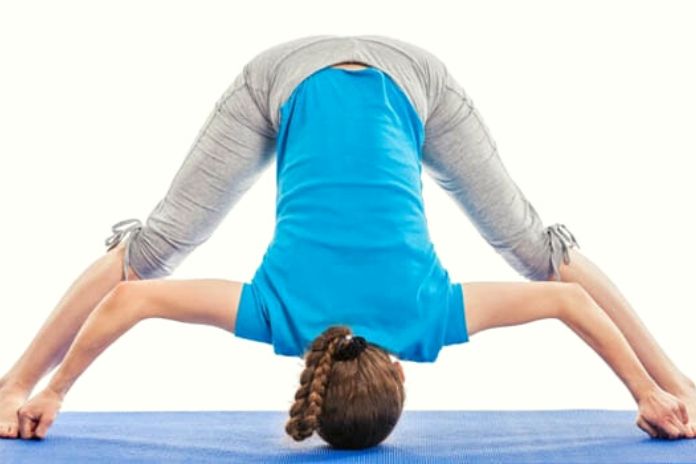The spread feet posture (Prasarita Padottanasana) is a yoga posture that comes in several versions A, B, C, and D, allowing everyone to find a variation that suits them. Plus, it’s a great pose if you’re looking to stretch your hamstrings, relieve back tension, and work on your hip opening.
What Are The Benefits Of The Spread-Toe Pose?
If you regularly practice the posture of the spread feet (Prasarita Padottanasana), it can help you to:
- Stretching the hamstrings and adductors: This pose is excellent for people who want to stretch their hamstrings and adductors. Indeed, in this posture, we benefit from the effect of gravity to go a little further in stretching than in seated postures.
- Relax the spine: Here too, gravity plays in your favor and helps you find a little more length in the spine, which allows you to stretch it and thus reduce tension.
- Open the shoulders and the rib cage: In this position, we try to open the shoulders, which favors the rib cage’s opening. You will feel more of the sensation of opening the rib cage in versions C and D.
- Calm the mind: If you have enough flexibility to place the top of the head on the ground (or on a block), it gives a calming sensation and helps to calm the mind.
How Do They Spread Feet Posture?
Version A
- Stand with your feet hip-width apart in the center of your mat, with your hips parallel to the edges of the mat.
- Place your hands on your hips and spread your feet to either side of the mat while keeping them parallel.
- Press your feet into the floor, engage your abs, and bend your torso forward from the hips in a forward bend motion.
- Place your two palms on the ground shoulder-width apart, keeping your hands under your elbows and elbows bent at 90° pointing backward to have your forearms perpendicular to the ground and your biceps parallel.
- Be careful not to collapse into your shoulders. Keep them away from the ears.
- Lengthen your spine and keep your head in line with the spine while looking behind you between your legs.
In this posture, feel the anchoring of the feet in the ground, the legs’ engagement, the hips’ opening, and the stretching of the hamstrings, the spine, and the shoulders.
C-Version
- Repeat the first two steps of version A.
- Press your feet into the floor, engage your abs, interlace your hands behind your back, pull your shoulders away from your ears and bend your torso forward from the hips in a forward bend motion.
- Lengthen your spine, extend your arms to the sky to open the rib cage, and keep your head in line with the spine while looking behind you between your legs.
In this posture, you feel more or less the same sensations as in version A but also the engagement of the arms as well as the opening of the rib cage.
D-Version
- Repeat the first two steps of version A.
- Put your two palms on the ground shoulder-width apart, take a deep breath, then spread your arms to catch your big toes with your hands. The elbows should be pointing outwards from the legs.
- Lengthen your spine and keep your head in line with the spine while looking behind you between your legs.
Variations Of Prasarita Padottanasana
You have seen several arm positions for the spread-toe pose (Prasarita Padottanasana), but there are other possible variations if you have difficulty performing this pose. If you can’t touch the ground with your hands, you can place blocks in front of you and press your hands against them. Use the block level that works best: small, medium, or large. If you find this pulls your hamstrings too much, bend your knees slightly to promote forward bend and reduce strain on your hamstrings. If you are looking to calm down in this posture and your head is not touching the ground, place one (or more) block in front of you and place the top of your head on it. It will also help you go deeper into the hamstring stretch and the hip opener because you will be more relaxed.
Contraindications
Please note it is not advisable to practice this posture if you suffer from back, ankle, hamstring, hip, shoulder, or neck pain.
Read Also: Nitrites And Nitrates In food: What Are The Effects On Our Health
